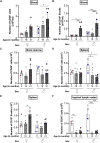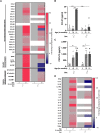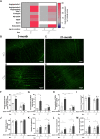Aging modulates homeostatic leukocyte trafficking to the peritoneal cavity in a sex-specific manner
- PMID: 37309034
- PMCID: PMC10533226
- DOI: 10.1093/jleuko/qiad053
Aging modulates homeostatic leukocyte trafficking to the peritoneal cavity in a sex-specific manner
Abstract
Aging is associated with exacerbated systemic inflammation (inflammaging) and the progressive loss of immune system function (immunosenescence). Leukocyte migration is necessary for effective immunity; however, dysregulated trafficking of leukocytes into tissue contributes to inflammaging and the development of age-related inflammatory diseases. Aging modulates leukocyte trafficking under inflammatory conditions; however, whether aging modulates leukocyte trafficking under homeostatic conditions remains to be elucidated. Although immune responses are evidently sexually dimorphic, limited studies have investigated the effect of sex on age-related changes to leukocyte trafficking processes. Here, we investigated age-related and sex-specific changes to the leukocyte populations within the peritoneal cavity of young (3-mo), middle-aged (18-mo) and old (21-mo) male and female wild-type mice in the steady state. We found an age-related increase in the number of leukocytes within the peritoneal cavity of female mice, predominantly B cells, which may reflect increased trafficking through this tissue with age. This was accompanied by an increased inflammatory environment within the aged cavity, including increased levels of chemoattractants, including B cell chemoattractants CXCL13 and CCL21, soluble adhesion molecules, and proinflammatory cytokines, which was more pronounced in aged female mice. Intravital microscopy techniques revealed altered vascular structure and increased vascular permeability within the peritoneal membrane of aged female mice, which may support increased leukocyte trafficking to the cavity with age. Together, these data indicate that aging affects homeostatic leukocyte trafficking processes in a sex-specific fashion.
Keywords: T cells; aging; inflammation; leukocyte trafficking; sexual dimorphism.
© The Author(s) 2023. Published by Oxford University Press on behalf of Society for Leukocyte Biology.
Conflict of interest statement
Conflict of interest A.J.I., H.M.M., and M.C. hold patents related to an immunomodulatory peptide. A.J.I. has received funding from F. Hoffmann-La Roche AG. All other authors have no conflicts of interest to declare.
Figures




Comment in
-
Being old and female is an inflammatory combination.J Leukoc Biol. 2023 Sep 27;114(4):299-300. doi: 10.1093/jleuko/qiad077. J Leukoc Biol. 2023. PMID: 37403216 No abstract available.
Similar articles
-
Dysregulation of leukocyte trafficking in ageing: Causal factors and possible corrective therapies.Pharmacol Res. 2021 Jan;163:105323. doi: 10.1016/j.phrs.2020.105323. Epub 2020 Dec 1. Pharmacol Res. 2021. PMID: 33276099 Review.
-
Syndecan-1 in the mouse parietal peritoneum microcirculation in inflammation.PLoS One. 2014 Sep 3;9(9):e104537. doi: 10.1371/journal.pone.0104537. eCollection 2014. PLoS One. 2014. PMID: 25184228 Free PMC article.
-
Being old and female is an inflammatory combination.J Leukoc Biol. 2023 Sep 27;114(4):299-300. doi: 10.1093/jleuko/qiad077. J Leukoc Biol. 2023. PMID: 37403216 No abstract available.
-
Sphingosine 1-phosphate-dependent trafficking of peritoneal B cells requires functional NFkappaB-inducing kinase in stromal cells.Blood. 2008 May 1;111(9):4646-52. doi: 10.1182/blood-2007-10-120071. Epub 2008 Feb 21. Blood. 2008. PMID: 18292290
-
Lipid-cytokine-chemokine cascades orchestrate leukocyte recruitment in inflammation.J Leukoc Biol. 2012 Feb;91(2):207-15. doi: 10.1189/jlb.0811402. Epub 2011 Nov 4. J Leukoc Biol. 2012. PMID: 22058421 Free PMC article. Review.
Cited by
-
Innate immunity in peripheral tissues is differentially impaired under normal and endotoxic conditions in aging.Front Immunol. 2024 Aug 16;15:1357444. doi: 10.3389/fimmu.2024.1357444. eCollection 2024. Front Immunol. 2024. PMID: 39221237 Free PMC article.
-
Rejuvenation of leukocyte trafficking in aged mice through PEPITEM intervention.NPJ Aging. 2024 Jul 18;10(1):33. doi: 10.1038/s41514-024-00160-6. NPJ Aging. 2024. PMID: 39025913 Free PMC article.
-
Age- and sex-associated differences in immune cell populations.iScience. 2025 Jul 10;28(8):113092. doi: 10.1016/j.isci.2025.113092. eCollection 2025 Aug 15. iScience. 2025. PMID: 40740500 Free PMC article.
-
Immunoinflammation and post-translational modifications in the aging process.J Transl Med. 2025 Aug 14;23(1):910. doi: 10.1186/s12967-025-06892-7. J Transl Med. 2025. PMID: 40814109 Free PMC article. Review.
-
Proteoglycan-4 (PRG4) serum concentration is lower in aged mice, and genetic deficiency impacts survival probability, blood parameters, and bone during aging.Geroscience. 2025 Jun 19. doi: 10.1007/s11357-025-01747-x. Online ahead of print. Geroscience. 2025. PMID: 40537697

